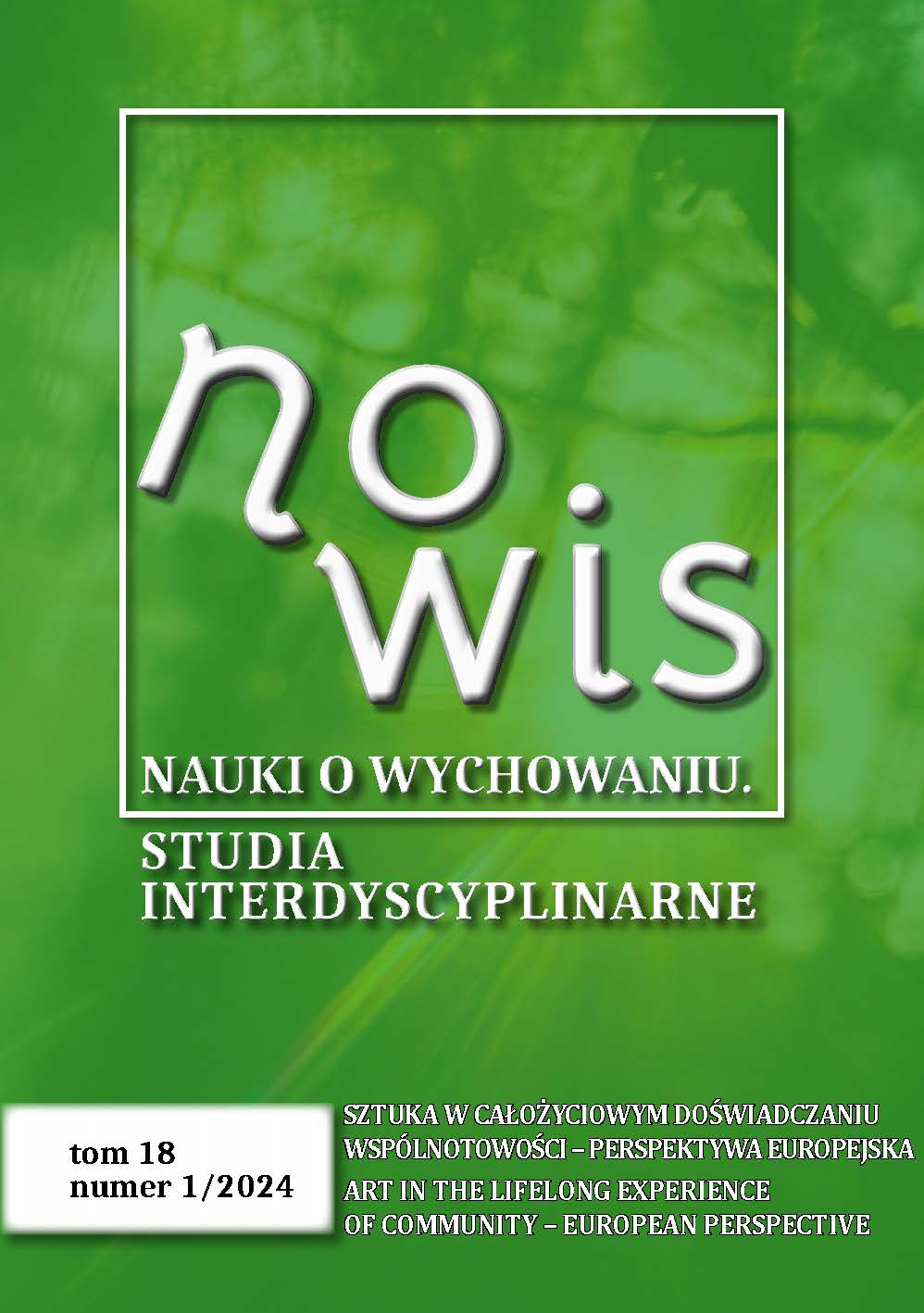The Community-Building Potential of Street Art: Ephemeral Communities Formed Around Ephemeral Art
DOI:
https://doi.org/10.18778/2450-4491.18.07Keywords:
street art, graffiti, art in public space, art and communitiesAbstract
The article analyzes the phenomenon of street art in the context of its impact on the creation of local or global communities of both creators and audiences. It takes into consideration various forms of expression such as graffiti, community murals, or interventions by individual artists. It examines to what extent the communities formed around artistic activities are lasting and cohesive. Graffiti, as a form of art typical of the hip-hop subculture, represents expressions by groups that are closed and anonymous for the majority of society. Despite strong connections, these groups are usually temporary and may disband after the completion of specific projects. Other forms of street art are typically created by individual artists seeking to develop a unique style. Open, global networks of enthusiasts, activists, and organizations form around them, with the internet and social media serving as platforms used to maintain the connection between artists and their audience. Some street artists (e.g. JR or Swoon) are particularly sensitive to social issues and contribute to forming and sustaining local communities through their creations, even if they do not necessarily belong to them. A specific form of street art are community murals commissioned by a community to enhance its identity and cohesion. Street art and graffiti, therefore, have the ability to create communities on various levels, even despite their informal and ephemeral nature.
References
Baudrillard J. (2007) Wymiana symboliczna i śmierć, trans. S. Królak, Warszawa, Wydawnictwo Sic!
Google Scholar
Bensaïd H. (2016) Mural painting and the Spirit of The Place Versus Graffiti and Street Art in: Aesthetic Energy of the City. Experiencing Urban Art & Space, A. Gralińska-Toborek, W. Kazimierska-Jerzyk (eds.), Łódź, Wydawnictwo Uniwersytetu Łódzkiego i Fundacja Urban Forms, pp. 155–157, https://doi.org/10.18778/8088-151-8.10
Google Scholar
DOI: https://doi.org/10.18778/8088-151-8.10
Cockcroft E., Weber J. P., Cockcroft J. (1998) Toward a People’s Art: The Contemporary Mural Movement, Albuquerque, NM, University of New Mexico Press.
Google Scholar
Conrad D. (1995) Community, Murals as Democratic Art and Education, “The Journal of Aesthetic Education”, vol. 1, no 29, pp. 98–102, https://doi.org/10.2307/3333522
Google Scholar
DOI: https://doi.org/10.2307/3333522
Gralińska-Toborek A. (2019) Graffiti i street art. Słowo, obraz, działanie, Łódź, Wydawnictwo Uniwersytetu Łódzkiego, https://doi.org/10.18778/8142-237-6
Google Scholar
DOI: https://doi.org/10.18778/8142-237-6
Gralińska-Toborek A. (2022) Street Art: Between Integration and Dispersion. A Global Collective of Individualities, “Art Inquiry. Recherches sur les arts”, no. XXIV, pp. 319–332.
Google Scholar
Hansen S., Flynn D. (2015) ‘This Is Not a Banksy!’: Street Art as Aesthetic Protest, “Continuum: Journal of Media & Cultural Studies”, vol. 6, no. 2, pp. 1–15, https://doi.org/10.1080/10304312.2015.1073685
Google Scholar
DOI: https://doi.org/10.1080/10304312.2015.1073685
Hansen S., Flynn D. (2016) ‘Darling Look! It’s A Banksy!’. Viewers’ Material Engagement With Street Art And Graffiti in: Aesthetic Energy of the City. Experiencing Urban Art & Space, A. Gralińska-Toborek, W. Kazimierska-Jerzyk (eds.), Łódź, Wydawnictwo Uniwersytetu Łódzkiego i Fundacja Urban Forms, pp. 103–115, https://doi.org/10.18778/8088-151-8.06
Google Scholar
DOI: https://doi.org/10.18778/8088-151-8.06
Juskowiak Piotr (2010) Sztuka wspólnoty Krzysztofa Wodiczki. Wokół Projekcji Poznańskiej, “Praktyka Teoretyczna”, no. 1, pp. 68–80, https://doi.org/10.14746/prt.2010.1.5
Google Scholar
DOI: https://doi.org/10.14746/prt.2010.1.5
Kelling G. E., Coles C. M. (2010) Wybite szyby. Jak zwalczyć przestępczość i przywrócić ład w najbliższym otoczeniu, trans. Bolesław Ludwiczak, Poznań, Media Rodzina.
Google Scholar
Lewishon C. (2008) Street Art. The Graffiti Revolution, London, Tate Publishing.
Google Scholar
Lippard L. (1984) Trojan Horses: Activist Art and Power in: Art after Modernism: Rethinking Representation, B. Wallis (ed.), New York–Boston, New Museum of Contemporary Art; D.R. Godine, pp. 341–358.
Google Scholar
Macdonald N. (2001) The Graffiti Subculture: Youth, Masculinity and Identity in London and New York, New York, Palgrave Macmillan.
Google Scholar
Maffesoli M. (2008) Czas plemion. Schyłek indywidualizmu w społeczeństwach ponowoczesnych, trans. M. Buholc, Warszawa, Wydawnictwo Naukowe PWN.
Google Scholar
Mancini L. (2019) Graffiti as a Gift: Street Art’s Conceptual Emergence, “Nuart Journal”, vol. 1, no. 2, pp. 30–35.
Google Scholar
Manco T. (2014) Big Art/Small Art, London, Thames & Hudson.
Google Scholar
Moch W. (2016) Street art i graffiti. Litery, słowa i obrazy w przestrzeni miasta, Bydgoszcz, Wydawnictwo Uczelniane Wyższej Szkoły Gospodarki & Włodzimierz Moch.
Google Scholar
Niziołek K. (2015) Czy street art jest sztuką społeczną? Kulturotwórczy i obywatelski sens sztuki ulicznej w perspektywie koncepcji społecznych enklaw, “Pogranicze. Studia Społeczne”, no. XXVI, pp. 49–74, https://doi.org/10.15290/pss.2015.26.03
Google Scholar
DOI: https://doi.org/10.15290/pss.2015.26.03
Riggle N. A. (2010) Street Art: The Transfiguration of the Commonplaces, “The Journal of Aesthetics and Art Criticism”, vol. 68, no. 3, pp. 243–257.
Google Scholar
Sztabiński G. (2011) Inne idee awangardy. Wspólnota, wolność, autorytet, Warszawa, Wydawnictwo Neriton.
Google Scholar
JR (2022) Can Art Change the World?, TED talk, https://www.youtube.com/watch?v=2fY-iSzbls8 (accessed: 03.01.2024).
Google Scholar
Kazimierska-Jerzyk W., Latuszewska-Syrda T. (2020) Street Art Decade. Urban Forms Gallery 2009–2019, Lisboa–Łódź, Fundacja Urban Forms, Urban Creativity, https://www.academia.edu/44696335/Street_Art_Decade_Urban_Forms_Gallery_2009_2019 (accessed: 03.01.2024).
Google Scholar
Litorowicz A., Sztuka w przestrzeni publicznej, https://sztukapubliczna.pl/pl/sztuka-w-przestrzeni-publicznej/sztuka (accessed: 03.01.2024).
Google Scholar
Urban Art Workshops for Seniors in: Google Arts & Culture, Street Art for All Ages, https://artsandculture.google.com/story/ZwXxxQqXfgsA8A (accessed: 03.01.2024).
Google Scholar
Ptak A. (2008) Community Arts: wprowadzenie do idei in: Lokalnie: animacja kultury/community arts, I. Kurz (red.), Warszawa, Instytut Kultury Polskiej, UW, pp. 36–51; https://ikp.uw.edu.pl/wp-content/uploads/2015/04/lokalnie.pdf (accessed: 03.01.2024).
Google Scholar
Curry C. The Road Home, https://swoonstudio.org/projects-1#/new-gallery-1/ (accessed: 03.01.2024).
Google Scholar












